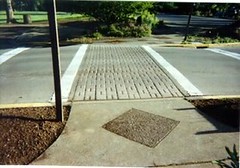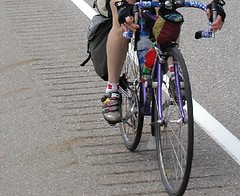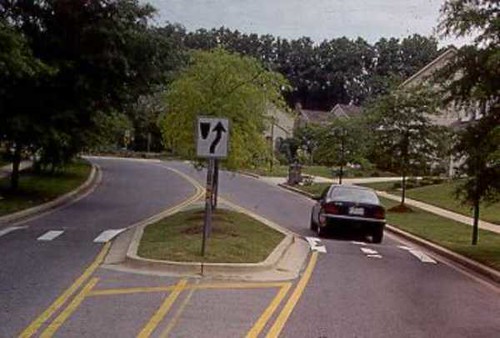I wish I liked traffic calming more than I do

Posted September 15, 2008 at 1:46PM
I know I am supposed to like traffic calming. The smart growth literature is replete with references to it. Heck, my friend Reid wrote the book on it. The Complete Streets gang, whom I support and admire, embraces the practice in their toolbox. Todd Litman of the Victoria Transport Policy Institute, whose excellent work I have cited in this blog before, has an articulate chapter on its benefits and techniques.
The techniques, as you probably know, include the speed humps, traffic islands, street diversions and closures, little roundabouts, rumble strips, raised crosswalks and the like that are now ubiquitous in America's residential (and some commercial) neighborhoods.  I agree with much of the philosophy behind traffic calming, which is to tame automobile speeds in order to make streets safer and more pleasant for pedestrians and other users.
I agree with much of the philosophy behind traffic calming, which is to tame automobile speeds in order to make streets safer and more pleasant for pedestrians and other users.
The problem is that I ride a bike. And the impact of these measures on me and my 20-pound machine (17 if I'm riding my racing bike ;) is a lot more significant than it is on a driver behind the wheel of a 4000-pound SUV or even a 2500-pound compact.
One of my regular training routes goes out from my part of the city to the suburbs on nice smooth roads, and then through a residential area up and then down a steep hill that is long on both sides. On the ascent, which does go through several intersections and lots of houses and driveways (but no sidewalks!), I must traverse five speed humps that make an already-steep climb harder.
After the summit, the route used to be a great place to practice my descending, because there were no side streets and almost no driveways on my side of the road to make it dangerous.  The sightlines were long and clear, the pavement smooth. I had to make sure to slow by the bottom where the route joins a busier road, but that was fine. It was, until they put the speed humps on it. Now there's no way to take the descent without braking before each one, unless I don't mind shattering some bones in a crash.
The sightlines were long and clear, the pavement smooth. I had to make sure to slow by the bottom where the route joins a busier road, but that was fine. It was, until they put the speed humps on it. Now there's no way to take the descent without braking before each one, unless I don't mind shattering some bones in a crash.
But that's not as annoying as navigating the bumps on an uphill at the end of a hard ride. In an article in the local newspaper a week or so ago, there was a feature on my neighborhood, and within it was a prominent picture of one of my neighbors a few blocks away (by coincidence, someone I worked with long ago and remember as a nice guy) who, among other things, is very pleased that his street now has speed humps and a traffic island that has converted what used to be a gradual turn into a sharp one. (The photo of the spot was in the paper but I can't reproduce it here because of copyright issues.)
Well, for me my neighbor's awkward traffic island and speed humps come near the end of a mile-plus climb, quite steep in places, and they make me work harder at the end of a hard ride. I pretty much hate them. So do his neighbors on a parallel street, by the way, since drivers now use their street more often instead of his.
 Worst of all are rumble strips, which I encounter on another couple of descents and which are both bone-jarring to me and component-jarring to my bike. What the hell? (By the way, do an image search for "rumble strips" and you'll soon find way too many photos of a deservedly obscure British band.) Amazingly, one of the oft-cited merits of traffic calming is that it makes cycling more convenient. Those who make that argument either don't ride bikes themselves or don't ride the same routes that I do.
Worst of all are rumble strips, which I encounter on another couple of descents and which are both bone-jarring to me and component-jarring to my bike. What the hell? (By the way, do an image search for "rumble strips" and you'll soon find way too many photos of a deservedly obscure British band.) Amazingly, one of the oft-cited merits of traffic calming is that it makes cycling more convenient. Those who make that argument either don't ride bikes themselves or don't ride the same routes that I do.
I don't particularly care for these things when driving, either, but it's orders of magnitude better than when I'm on my bikes and I can see the benefits outweighing the costs in many situations. Either way, though, I particularly don't like the practice of closing ends of streets altogether or drastically restricting their access, in effect converting grid-patterned blocks into the rough equivalent of suburban cul-de-sacs. We can't on the one hand argue that street grids can reduce traffic congestion by providing alternative routes and then on the other hand take those routes away, both in the name of smart growth.
I certainly won't dispute that cars have dominated our street culture way too much for way too long, and I do think traffic calming of an appropriate sort deserves a role in building better communities, including my own. But there have to be better ways of doing it, and my friends who advocate the practice can probably point to many of them.  Unfortunately, some of those ways (such as building narrower streets) aren't easily available for retrofit situations, and the others don't seem to be popular where I live.
Unfortunately, some of those ways (such as building narrower streets) aren't easily available for retrofit situations, and the others don't seem to be popular where I live.
Before closing, I have to say that there is another aspect of all this that I haven't completely sorted out for myself, but that troubles me. I think there can be a subtle and unspoken aim of some in the transportation advocacy world to address our country's problems with automobile dependence primarily by adding burdens to driving, to make it less convenient. This can take the form of imposing steep fees on drivers, taking their parking and driving lanes away, obstructing their routes, and various other measures. (Some critics who are more stringent than I refer to traffic calming in particular as "induced congestion.")
I don't agree with this approach, although I reserve the right to in specific circumstances, case-by-case. What smart growth needs is more friends, and that includes drivers. Our strategy should be to make our walking, cycling, and transit options much better so that they become more competitive with driving. It's about providing choices, not taking them away. It's also about building communities so that even those who must or prefer to drive can do so over shorter distances, saving fuel and CO2 emissions. In the end, if smart growth doesn't work for everyone, including drivers (and cyclists), it will be destined to become only a niche market.
